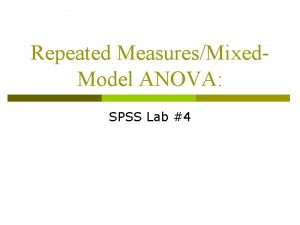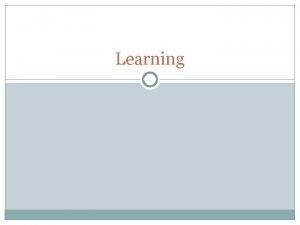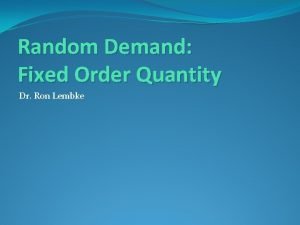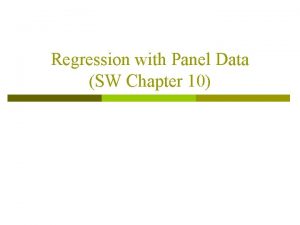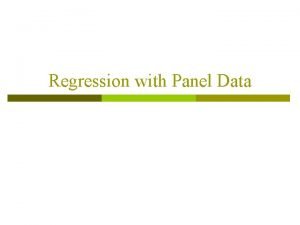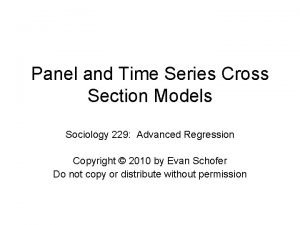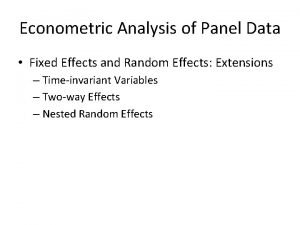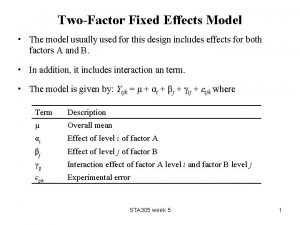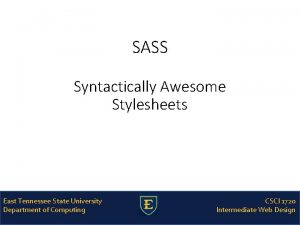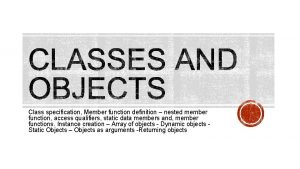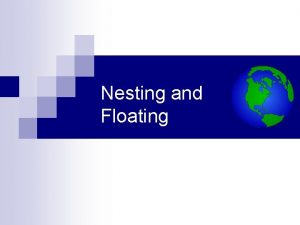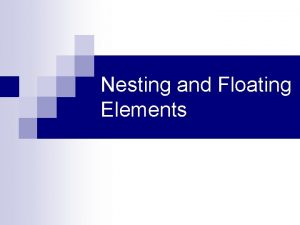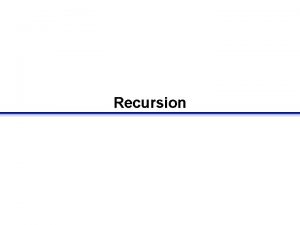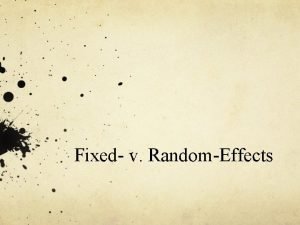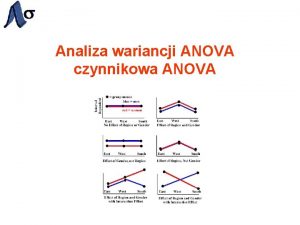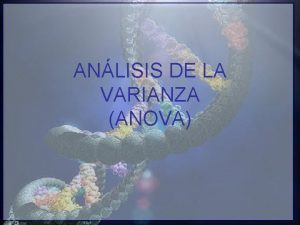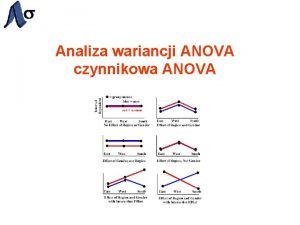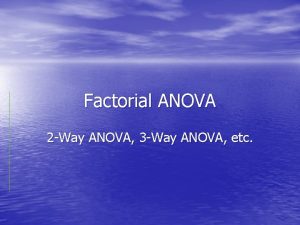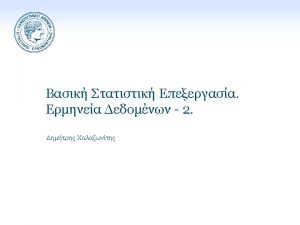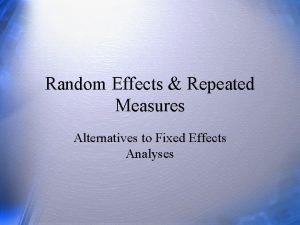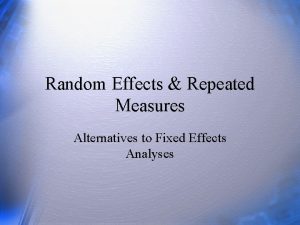Fixed Random and Mixed Effects ANOVA And Nesting




















- Slides: 20

Fixed, Random, and Mixed Effects ANOVA And Nesting and Crossing of Factors

Sampling Fractions • Sampling fraction, sf, for classification variable = levels in the sample divided by levels in the population. • If the sample includes every level in the population of interest, sf = 1. This is a fixed effect. • If the sample has a random set of levels, then sf = integer/ =0. This is a random effect.

Fixed Effect • Diagnosis given to patient – Melancholic depression – Postpartum depression – Seasonal affective disorder • There are no other levels of diagnosis in which I am interested. • sf = 3/3 = 1.

Random Effect • Dose of experimental therapeutic drug • Population of interest = all values from 0 to 100 units of the drug • I randomly select 5 values, using SAS – Do Value=1 To 5; Dose=round(100*Uniform(0)); Output; End; • sf =5/ = 0.

Mixed Effects • Factorial Design: Group (fixed) x Dose (random) • When there are random effects in the model, one need carefully consider how to compute the F ratios. • It will not always be MSeffect / MSerror

How to Compute F • You want F to be • See page 433 of Howell for the expected values of the mean squares for models that include random factors.

Expected Values for MS • Main effect of group (fixed) – Group + Interaction + Error • Main effect of dose (random) – Dose + Error • Interaction of group and dose – Interaction + Error • Within cells error (MSE) – Error

F for Main Effect of Group • If the null is true, group has no effect, and we expect the F to equal

F for Main Effect of Dose • If the null is true, dose has no effect, and we expect the F to equal

F for Main Effect of Interaction • If the null is true, the interaction has no effect, and we expect the F to equal

GLM’s Test Statement Use Test to specify the denominator for any effect where it should be other than MSE. proc glm; class group dose; model score = group|dose / ss 3; Test H = group E = group*dose; title 'Mixed Effects ANOVA: Group is fixed, dose is random'; run;

Power Considerations • Interaction mean squares typically have few degrees of freedom • This can lower power, because MS = SS/df, so the interaction MS tends to be large. • You may be able to enhance power by dropping the interaction term from the model.

Pooled Interaction and Error • If the p for the interaction term ≥. 25, drop it from the model. • Its SS and df are now pooled with the error SS and df. • You then use this pooled error term in the denominator of F. proc glm; class group dose; model score = group dose / ss 3; title 'Main Effects Only, Interaction Pooled Within-Cells Error'; run;

Subjects as a Random Factor • What we call “error” is really the effect of subjects (nested within groups). • We pretend that the values for the subjects variable are a random sample of the population of interest. • If we considered subjects to be a fixed factor, we would not need ANOVA, we would have the entire population of interest.

Nested Factors • Suppose one factor was Households and another was Neighborhoods. • Households would be nested within Neighborhoods – each household is in only one neighborhood. • If you know the identity of the household, you also know the identity of the neighborhood.

Households Nested Within Neighborhoods Nborhd 1 Nborhd 2 Nborhd 3 H 1 H 6 H 11 H 2 H 7 H 12 H 3 H 8 H 13 H 4 H 9 H 14 H 5 H 10 H 15

Crossed Factors • Here we have each possible combination of level of Factor A and level of Factor B. • For example, suppose that one factor is Teachers, the other is Schools, and each teacher taught at each of the three schools. School 1 School 2 School 3 T 1 T 1 T 2 T 2 T 3 T 3

Between Subjects With this design, the subjects factor is nested within each level of the grouping factor(s). Group 1 Group 2 Group 3 S 1 S 4 S 7 S 2 S 5 S 8 S 3 S 6 S 9

Within Subjects With this design, the subjects factor is crossed with the other factor. Condition 1 Condition 2 Condition 3 S 1 S 1 S 2 S 2 S 3 S 3

Omega Squared • Its computation in model with random factors is different than in models with only fixed effects. • See pages 438 -440 in Howell.
 Beda one way anova dan two way anova
Beda one way anova dan two way anova One way anova vs two way anova
One way anova vs two way anova Analiza anova
Analiza anova Multivariate anova spss
Multivariate anova spss Fixed and and fixed or is part of which pld
Fixed and and fixed or is part of which pld Cost behavior patterns
Cost behavior patterns Schedules of reinforcement psychology
Schedules of reinforcement psychology Variable interval positive reinforcement
Variable interval positive reinforcement Variable interval
Variable interval Fixed order quantity
Fixed order quantity Random assignment vs random sampling
Random assignment vs random sampling Random assignment vs random selection
Random assignment vs random selection Time fixed effects
Time fixed effects Time fixed effects
Time fixed effects Panel data
Panel data Time fixed effects
Time fixed effects Fixed effects model
Fixed effects model In which of the following practices
In which of the following practices Nesting in css
Nesting in css Class specification in c++
Class specification in c++ Anova within group and between group
Anova within group and between group



